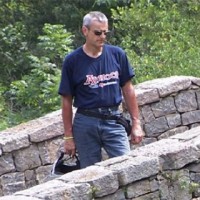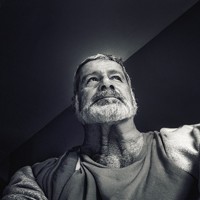SEARCH






|
|
|
|


I often wonder why photographers want their landscapes to look like paintings and why viewers appreciate them for the same reason. For me paintings and photographs are equal forms of artistic expression. When I am comparing the two here, then it is because of their influence on each other. There are however still people who hold the opinion that photography is to some extent inferior to paining, a view that dates back to the early days of photography.
Painters and photographers were greatly influenced by the art of the Romantic period. In particular landscape photographs of photographers such as Anselm Adams - who has influenced and inspired generations of photographers - have that romantic grandeur, one can also experience in the landscape paintings of artists such as Caspar David Friedrich, J.M.W. Turner and John Constable.
Max Rive's photo is an example of the Romantic look and feel of the nineteenth century. However when browsing in my art history book, I discovered this atmosphere also in Chinese landscape paintings by Ma Yüan and Kao K'O-Kung, who lived in the thirteenth century. The Romantic painters were possibly also influenced by these artists and passed it on to landscape photographers.
Of course Romantic approach with its emphasis on the purity of nature, the majestic mountain ranges and waterfalls isn't the only way of viewing a landscape. In addition to the romantic landscape, other categories of imaging landscape are for example: the surreal landscape, the abstract landscape, the flat landscape, the graphical landscape.
Missing from this list are examples of the "New Topographics or Photographs of a Man-altered Landscape" movement. The New Topographers with Robert Adams as one of the most prominent representative, showed that the grandeur of the landscapes as photographed by Ansel Adams for example, was but a one sided view, which excluded the human intervention in the landscape such as the construction of roads and suburban developments. The new topographics don’t have that factor of awe, as often seen in the more traditional landscape photographs. It really takes time to discover their beauty. The photos are usually very formal, stark and purely documentary and, so it seems, show an aesthetic of the banal.
An example of New Topographics photography - just to give you an idea of this genre. I will explore it more extensively later on.
The Romantic landscape
The Romantics celebrated the spontaneity, imagination, and the purity of nature. A landscape painting had to arouse a mood and artists expressed their inner feelings and passions on the canvas. Similar to what Barbara Seiberl-Stark and Yann Deguan attempted through their photographs.
Barbara shows how spectacular it must have been, when after a rainy night the golden light of the sun broke through the clouds. No wonder she grabbed her camera and photographed the scene as it developed before her very eyes. Viewing her photograph full of Romantic grandeur, I can literally feel the happiness of experiencing this moment of sheer beauty.
The surreal landscape
In a way the surrealists can be considered the grandchildren of the Romantic artists. Both wanted to free themselves from the bourgeois reality. They wanted to dream and show it in an original way by combining the tangible reality with a supernatural reality. They have however different views on the subject matter of beauty. The Romantics sought beauty in the aesthetic. For the surrealists however the beauty could be found primarily in the message that was conveyed to to the viewer.
In his photograph "Family" José Antonio Sánchez attempts to wrap his surreal message into the aesthetic of the Romantics. The dark, threatening clouds, the reflection of the trees in the water, the play with the light, are all elements of the Romantic era.. The photo gets its surreal touch by its message and its supernatural reality. The landscape becomes a dreamscape with two trees on a green meadow lost between water and clouds, possibly the sole survivors of a flood or other catastrophy. They have no eye for their problematic environment. Life goes on as it is - big brother rebuking the little one. And so, in a surrealist or Dadaist way, an inherently tragic situation is made lighter by a delightful, possibly even ironic sense of humor.
Fresh bushes, threatening clouds, a figure that closes a glass case, where the last tree will be preserved as a museum piece. It is a fantasy world with a clear and very timely message, in an era of increased awareness of environmental pollution and climate change.
In his surreal packaged message David Senechal goes a step further than José Antonio Sánchez. Although it is five to twelve, Jose's trees go on with their daily lives, as if nothing has happened. David shows the result of this attitude in his rather gloomy photo. Like José he uses the aesthetic of the Romantics to communicate his message.
The graphical landscape
And now something completely different - the graphical landscapes by Ahmed Abdulazim and Wei Tang.
The photographs show us but a part of a landscape with a lake. We have no idea if the lake is surrounded by mountains, hills or a plain. In fact it isn't very important whether we see more of the surroundings or not. Our mind fills in the gaps. It knows we are only seeing a pars pro toto (a part of the whole) and we now can concentrate on what we are really seeing. We see a reduced landscape in which many things are left out. We also see a play with forms, patterns, lines and some textures.
The textures in Ahmet's photo are crucial. They determine a labyrinth of repeating patterns, which make the photo graphically interesting.
In Tangs picture the textures are of no consequence. It is the rhythm of the patterns and forms that is the essence of the photograph.
Note also that in both photographs the tiny appearing fisherman in his boat is well positioned. He leads the eye into the picture and lets it roam among the fishing nets.
The abstract landscape
Seeing a landscape within a landscape or in something that has nothing to do with a landscape and thus creating a new reality. That's the point of abstract landscape photography - if not of all genres in abstract photography.
Color, forms and shapes define the abstract landscape photograph. One could also say that photographers uses the landscape - or something else - as a design element to build the composition.
Edoardo Gobattoni and Ursula Abresch have both opted for a lively composition with wavy horizontal lines, each with its own colors, shapes and patterns. But here the similarity between the two images ends. They are after all poles apart.
There are lots of things to discover in Edoardo's impressionistic landscape with waving cornfields, grass and - well possibly - blue bells and poppies. It is colourful and yet it seems to be rather introvert, like a sunny day in the country during a siesta.
It is quite a contrast with Ursula's expressionistic and extrovert image. It is like a statement about a mountain reflecting in a lake at sunset- not much to discover but a lot to enjoy. The funny fact is, that this landscape, isn't a landscape at all. It is, as Ursula explains, a landscape seen in a close-up of water in a pan.
The flat landscape
Photographing the flat land - not a lot 1X photographers are venturing into it. It is indeed not easy to see a photo of an almost endless polder or wide meadow area. Moreover, I think that a lot of landscape photographers take their pictures during the holidays, which are usually spent in more spectacular natural areas than the polders. But even those who live there don't explore them more,which is a pity, judging by the images by Piet Flour and Jacob Tuinenga, showing fascinating photographs from this setting.
Both pictures are cleverly composed, making use of the small country road leading the eye into the image and opening up the scenery. Now the eye can wander along and search for any striking details.
Most details are to be found in Piet's friendly evocation of the Flemish polder - the typical church spire, the village and farms at the horizon, the reeds edging the ditches waving gently in the ever-present wind. The only detail in Jacob’s photo is the struggling cyclist, who has to battle the stark weather, the wind, the rain, the cold in this menacing, bleak landscape.
The pictures show the two sides of the flat land. The pastoral and the ominous side and the yare both beautiful!
 | Write |
 | beppeverge Thank you for this interesting review! |
 | Edith Hoffman Great subject and well written Susanne, it was good to read. Thanks for that and also lovely choice of photographs! Have a great rest of the week and take care :-) |
 | Yvette Depaepe CREW Thank you, Edith !!! |
 | Piet Flour PRO oops, sorry, it's Susanne who wrote it ... anyway, congrats to both :-)
|
 | Yvette Depaepe CREW Thanks Piet ... Yes, Susanne is the author !!! Always a treat to read her clever and interesting reviews every month !!! |
 | Piet Flour PRO heel mooi gebracht thema Yvette; chapeau ! |